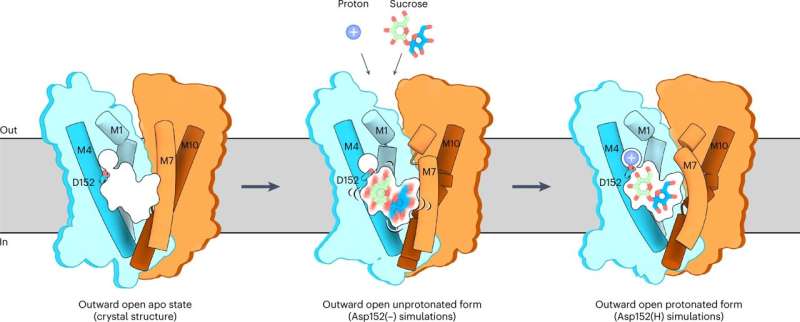Proposed mechanism of substrate recognition in SUC1 transport. The N and C domains are colored according to the SUC1 structure, with highlighted M1, M4, M7 and M10 shown as cartoons. Sucrose is shown in green and blue and the proton is shown as a blue sphere. Credit: Nature Plants (2023). DOI: 10.1038/s41477-023-01421-0
Plants, like humans, need to move sugar and other nutrients around their bodies to power their growth. But unlike humans, they do not have a heart to pump these vital nutrients. Instead, they use an amazing molecular pump mechanism that scientists have been studying for decades since its discovery more than 30 years ago.
Now, a team of researchers led by Associate Professor Bjørn P. Pedersen at the Department of Molecular Biology and Genetics at Aarhus University has made a groundbreaking discovery about the SUC transporter, one of the most important components of this pump mechanism. This molecule is like a microscopic sugar delivery truck that actively loads a type of sugar called sucrose (tabletop sugar) into the plant's "veins," which are called the phloem.
Until now, scientists have struggled to understand exactly how this transporter works. But the team's new research has uncovered the secrets behind how the SUC transporter recognizes sucrose and how it uses acid to power its sugar delivery. The results have been published in Nature Plants.
"This discovery is a breakthrough because it finally solves a long-standing mystery: how plants are able to sustain the loading of sucrose into the 'veins' and create the turgor pressure that generates the flow of all nutrients in the phloem," says Pedersen. "This is like the plant's 'heart' and it's critical for the plant's survival and growth."
The team's work also sheds new light on how plants defend themselves from pests. When plants are under attack, pests try to steal the sugar in the phloem. But the SUC transporter is essential for the plant's defense capabilities, and understanding how it works could help us protect plants from harmful bugs in the future.
The discovery is the result of five years research
This research is the result of more than five years of hard work by a talented team of scientists, including lead author Laust Bavnhøj and Jan Driller, as well as Lorena Zuzic, Amanda Stange, and Professor Birgit Schiøtt from the Department of Chemistry. It is a huge step forward in our understanding of how plants work at the molecular level.
"I am absolutely thrilled to finally publish the first-ever structure of the SUC transporter, which allowed us to visualize transporter function and together with our biochemical data illuminate the long-sought molecular mechanism behind sucrose transport," says Laust Bavnhøj, "starting this project from scratch back in 2018 has been a long and challenging journey."
More information: Laust Bavnhøj et al, Structure and sucrose binding mechanism of the plant SUC1 sucrose transporter, Nature Plants (2023). DOI: 10.1038/s41477-023-01421-0
Journal information: Nature Plants
Provided by Aarhus University
























